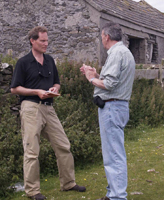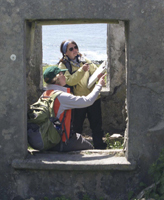
The last 24 human inhabitants of the island of Inishark off the coast of Galway, Ireland, departed together on October 20, 1960—a beautiful, sunny day which marked a solemn end to a steady decline that began in the mid 19th century.
That’s when a more robust population of 300 or so first began to drift away from Inishark—many sought a new life in America. By 1960, life on the island had become too remote, too hard, too dangerous, says Ian Kuijt, a professor in Notre Dame’s Department of Anthropology. “They never had electricity,” he says. “They never had phones.”
On the Connemara mainland nearby, these modern marvels were finally becoming commonplace. For most of the Irish, life was changing rapidly, and the people on Inishark realized they were being left behind. During medical emergencies the islanders were often reduced to signaling for help with hillside bonfires, and in 1959, stormy weather cut them off from the mainland for more than a month. “But the final straw was just the lack of young people,” says Kuijt.
The life on Inishark could not go on.
Capturing a Culture

This small community’s collapse more than 50 years ago now offers a unique opportunity to contemporary anthropologists like Kuijt—not just a freeze frame of island life in 1960 but “a window” to Irish life in the 19th century. “These people were living little differently than they were in the 1860s,” he explains.
Kuijt and his team of students, academics, and technicians from Notre Dame and Ireland are in a race to understand island life and capture the stories of the last 12 survivors of Inishark to preserve a portrait of their way of life before it disappears for good. The research is part of Cultural Landscapes of the Irish Coast, Kuijt’s six-year, multidisciplinary, inter-institutional study of coastal western Ireland.
Over the last four years, Kuijt and his team have made multiple field trips to Inishark, staying for up to 10 days at a time. They lug in enough equipment—computers, GPS, and video and audio gear—to quickly assemble a “rustic lab,” he says. Because of the site’s remoteness they must transport all their food and water.
Notre Dame anthropology student Claire Brown has roughed it on the island with Kuijt’s project for the past three summers and says the fieldwork has been one of the most compelling parts of her research experience.
“When we work on the island and survey the houses, I feel like I am seeing history come alive,” she says. “To be on the island and look at these houses that we have heard so much about during our interviews with the islanders is an incredible experience. It helps us understand history from a personal perspective.”
During these expeditions, students do a little bit of everything—from interviewing former island residents to constructing a detailed map of the village to participating in an archaeological excavation around abandoned houses.
Preserving Memories

Over the years Kuijt and his team have taken five of Inishark’s last inhabitants back to the island to tour the village and record their reminiscence. For the islanders and Kuijt’s students, the visits are profoundly bittersweet. The islanders are deeply moved to be back but heartbroken that this life could not go on. “Several of them tell me that when they dream,” says Kuijt, “they always dream that they are young children back on ‘Shark.’”
The survivors’ willingness to share their lives and commitment to getting the story told is all the encouragement Kuijt needs. He knows time is not on his side. “These are rich personal histories that help us to understand the past,” he says, stories the abandoned stone ruins of Inishark seem almost to tell. “If it doesn’t get written down now,” says Kuijt, “it will be lost forever.”
Like her professor, Brown says trying to capture the unique experience of the Inishark islanders has become more than just an anthropological challenge. “The project is certainly important in an academic sense but almost more so at the personal level,” she says. “We are in contact with those who lived on Shark who are still alive, and our research is very important to them. We are dealing with their histories and their lives, and they have been on the whole very appreciative of our efforts.”
This sense of mission has led Brown to continue working on aspects of the project beyond what is required for her coursework. “I feel a deep connection to the place and the people.”


